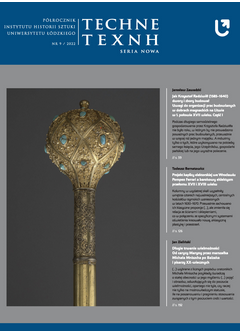Drudzy po królu. Marszałkowie koronni jako fundatorzy i właściciele rezydencji – inicjatywy warszawskie z XVII–XVIII wieku
Second after the King. Marshals of the Crown as founders and owners of the residences – Warsaw initiatives from the 17th–18th century
Author(s): Alina BarczykSubject(s): Cultural history, Architecture, 17th Century, 18th Century
Published by: Wydawnictwo Uniwersytetu Łódzkiego
Keywords: Warsaw; Crown marshals; Bieliński family; Mniszech family; Lubomirski family; residential architecture; 18th century; Tylman von Gameren; Saxon era;
Summary/Abstract: Thanks to their political and social position and financial resources, Crown Marshals were able to undertake extensive architectural investments. They were also aware of the importance of visual and ceremonial setting. The profiles of individual magnates (who performed this honourable function), as well as specific individual buildings, have been discussed in detail. The patronage of Stanisław Herakliusz Lubomirski – which manifested itself in the creation of the famous Łazienka (bath house) at Ujazdów – or the activity of Franciszek Bieliński, who ordered the design of the boudoir from J.A. Meissonier, can be mentioned here. However, no attempt has been made to indicate the features common to the marshals’ foundation mechanisms, or to answer the questions as to whether – and, if so, how - the marshal’s office determined the intensification or change of its foundation policy. The main goal of this article is an attempt at a synthetic and cross-sectional view of the activity of Crown Marshals in the space of the Royal City of Warsaw. Three important ways of marking their presence in urban space can be distinguished: establishing and taking over juridical estates (e.g. Bielino), founding monuments (e.g. the statue of St. John of Nepomuk at Three Crosses Square), and erecting or transforming residences and gardens. Interesting conclusions are also provided by an analysis of the location of Marshal’s palaces, most of which were situated near royal residences (the Castle, Saxon Palace), and at the same time near main transport arteries (e.g. on the road from Wola or on Nowy Świat Street). The choice of location was certainly not accidental – especially with regard to palaces performing various ceremonial functions. Reflection on the specific nature of the founding activity of the Lubomirski, Bieliński and Mniszech families and the ways in which they annexed urban space allows for a closer look at both the ambitions of the marshal’s families and the spatial development of Warsaw.
Journal: TECHNE. Seria Nowa
- Issue Year: 2022
- Issue No: 9
- Page Range: 155-183
- Page Count: 29
- Language: Polish

